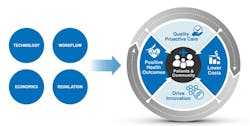What You’ll Learn:
- What is value-based care?
- How did COVID-19 speed up the development VBC and the remote monitoring systems?
- The four main challenges to overcome in value-based care, from technology to regulation.
The fee-for-service (FFS) economic model of healthcare in the U.S. and other parts of the world isn’t working. Healthcare costs have grown faster than both GDP and inflation for decades and have had little correlation to improvements in healthcare outcomes. The U.S., for example, spends twice as much as a percentage of its GDP than the average OECD (Organization for Economic Cooperation and Development) country, yet has a significantly lower life expectancy, more avoidable deaths and higher rate of chronic disease than average.1
While the healthcare cost/benefit challenge is complex, the FFS model is definitively not part of the solution. When healthcare providers are paid for the quantity and volume of services they deliver, rather than the outcome/value of their services, healthcare costs will inevitably increase. And when new technology extends the capability to provide care, cost increases even faster.
The result is a constant tension between healthcare providers, new technology and payers that focuses more on cost reduction and risk avoidance than improving patient outcomes.
In the global effort to rein in healthcare spending and improve outcomes, a new model—value-based care (VBC)—emerged nearly 15 years ago and has been steadily growing in popularity ever since. VBC turns the FFS model on its head, shifting the economic focus from the means (effort expended) to the end (value created in terms of quality, outcome, and cost).
Beyond the immediate beneficial economics, value-based care also offers the potential to move the healthcare model from a reactive one focused on treating disease to a proactive one focused on preventing and managing it.
Barriers to Adoption
Despite its beneficial impact for individual and population health, providers’ and payers’ adoption of value-based care has been slow, mostly due to resistance from those who benefit financially from the FFS model, but also simply due to inertia within the enormous healthcare industry.
Unsurprisingly, VBC’s completely different approach to healthcare and its economics has run into resistance from those who have operational and business models that need to be fundamentally retooled to take full advantage of the model. This includes providers, payers and suppliers.
In their defense, value-based care is a more complex healthcare model and traditionally there have been structural obstacles to its adoption, including scaling technology and staffing as well as complex regulatory frameworks. As a result, VBC’s promise has remained largely unfulfilled thus far in the private healthcare sector, except in a limited number of markets.
Medicare, however, has been a leading payer proponent. But even there, most commercial payers and Medicare Advantage plans have moved very slowly into VBC due to the same concerns listed above.
The Impact of COVID-19 on Accelerating Value-Based Care
COVID-19, though, is changing opinions about value-based care. In the early months of the pandemic, healthcare providers and payers mobilized to deliver patient care remotely to reduce the risk of contagion from in-person visits. Telehealth, which had always been the exception for care delivery, became a preferred model.
Smartphones, high-speed internet connectivity, Zoom and other collaboration tools, and healthcare portals facilitated the new approach. Care providers and patients discovered that many health issues could be safely addressed remotely with efficacy, convenience, and ease.
As payers realized that remote healthcare didn’t increase their risk, they also got on board. In addition, many providers discovered the economic benefits of capitated fees per patient (as opposed to FFS) during the pandemic when their cash flow wasn’t interrupted due to declines in elective treatment volume.
Demonstrating that care delivery could be liberated from centralized facilities was a crucial first step in the widespread adoption of value-based care. It proved that healthcare economics weren’t necessarily dependent on hospital utilization or location.
The growing development of innovative technologies for remote patient monitoring (RPM) is proving to be an equally significant catalyst for the adoption of VBC. For example, smartwatch-based oximeters and other home-based devices that measure blood oxygen levels helped patients and doctors oversee COVID-19 treatment outside of an office visit. Essentially, RPM creates the possibility of clinicians’ being able to virtually reach patients at home rather than just communicate with them via existing telehealth technology.
While the pandemic remains a continued threat today, many care providers and payers are beginning to consider how these innovative technologies can be applied in the post-pandemic era of healthcare. While there will likely be a partial return to traditional care models, significant obstacles to VBC adoption have been removed and the future healthcare landscape will look quite different.
Additional steps are necessary, however, before VBC can achieve its full potential. There are four areas in particular that will be crucial to that future: technology, workflow, economics, and regulation.
Value-Based Care’s Four Challenges
Technology
While remote-patient-monitoring technology has improved in recent years, we’re still not where we need to be. The Apple and Samsung watches, Garmins, Casios, and Fitbits that have proliferated over the past decade have come a long way since their initial use cases for measuring steps and heart rate. However, their precision, accuracy, and reliability are still not up to clinical measurement standards.
If your smartwatch misses a heartbeat or two, that’s not a big deal. If the RPM system on which treatment is being based makes an incorrect measurement, that’s a major issue. For RPM to be applicable to and effective for acute and sub-acute or chronic disease management at home, devices must deliver clinical-grade measurements equal to those used in the hospital setting.
Beyond accuracy, sensor integration also is critical. Sensors that are connected and integrated generate exponentially greater benefits versus independent sensors. For example, when the heterogeneous outputs of different sensors for ECG, thoracic impedance, and temperature are connected, synergies enable insights into patient body functions that aren’t being directly measured.
Combining integrated sensors, edge processing, artificial intelligence, and cloud-based analytics gives care providers access to powerful diagnostic information in the home. As a result, they can make timely clinical decisions before a patient enters an acute episode.
Workflow
The potential for having RPM’s continuous “eyes and ears” on patients is only a benefit, though, if its output aligns well with healthcare providers’ existing workflows. It’s important that remote-monitoring solutions don’t add to healthcare providers’ workloads, but rather provide early warnings of changes in patient condition. It’s not helpful to providers for RPM solutions to deliver data in a format that doesn’t fit into their existing systems or provides too much data that’s not actionable.
In the early days of cybersecurity, systems generated tremendous reams of data and alerts that were frankly overwhelming. Consequently, many system administrators and users simply started ignoring them due to “alert fatigue.”
Healthcare delivery is still constrained by the capacity of providers, so RPM systems need to be smart enough to streamline their output data through algorithms, AI, and machine learning. Therefore, doctors and nurses can focus only on the areas of greatest impact, offloading lesser impact activities to machines or others.
Economic
The third challenge to be overcome is the economics of value-based care. With current approaches to healthcare, the medical risk lies predominantly with the care provider and the financial risk lies predominantly with the payer. As a result, conflicting incentives in play result in greater utilization of expensive services, higher costs, and lesser patient outcomes.
Providers and payers need to align their risks and focus on using services in an evidence-based, clinically appropriate manner to both improve patient outcomes and manage costs. In addition, as providers sign on for a VBC model that’s impacted by numerous issues outside of their control (e.g., patient environments and behavior are more difficult to control than the provision of a CT scan or inoculation), payers need to recognize the challenges and find a win-win approach to provider payment.
Finally, patients need more transparency and must be more actively involved in the process. As we have seen in automotive insurance, patients can be incentivized to actively participate in improving their own outcomes to avoid the added cost of not participating.
Regulatory
Governments, with their hodgepodge of regulations, have created a Byzantine structure that hinders innovation in the healthcare ecosystem. Regulation is necessary to protect patients (and the larger ecosystem), but it needs to be updated from its largely FFS-focus to one that facilitates and promotes VBC.
For example, in the U.S., the Anti-Kickback Statute and the Stark Law, which laudably prevent fraud and abuse, make it impossible for payers to incentivize high-quality/high-value care. In addition, “best price” mandates by Medicaid and other government payers aren’t tuned to value or outcome, just cost, and result in market distortions that don’t benefit patients. Ultimately, regulation needs to focus on providing greater certainty, protection, and promotion for value-based care adoption to occur.
Taking Healthcare to Heart
The transition to a value-based care model of healthcare will be challenging and require significant change management, but the pandemic has changed the outlook and smoothed the path to its adoption. Now is the time for patients, care providers, payers, and the rest of the healthcare ecosystem including medical device and pharmaceutical manufacturers to come together to address the technical, workflow, economic, and regulatory hurdles to VBC.
On that front, Analog Devices is working closely with manufacturers, physicians and payers to develop innovative healthcare products, solutions, and models that promote VBC and improve the lives and well-being of patients. Approached thoughtfully and with value rather than cost as the guiding principle, healthcare systems can dramatically improve outcomes at the individual and population levels, which will generate the subsequent benefit of lower overall health costs.
This article appeared in Machine Design.
Reference
1. Mirror, Mirror 2021: Reflecting Poorly | Healthcare in the U.S. compared to other high-income countries | Commonwealth Fund




